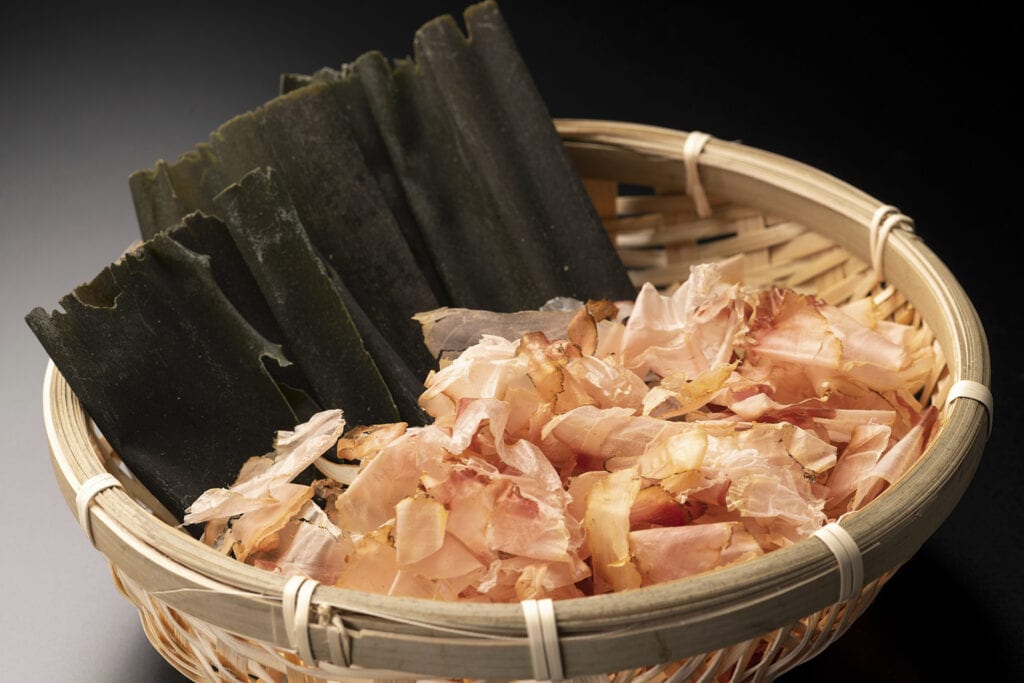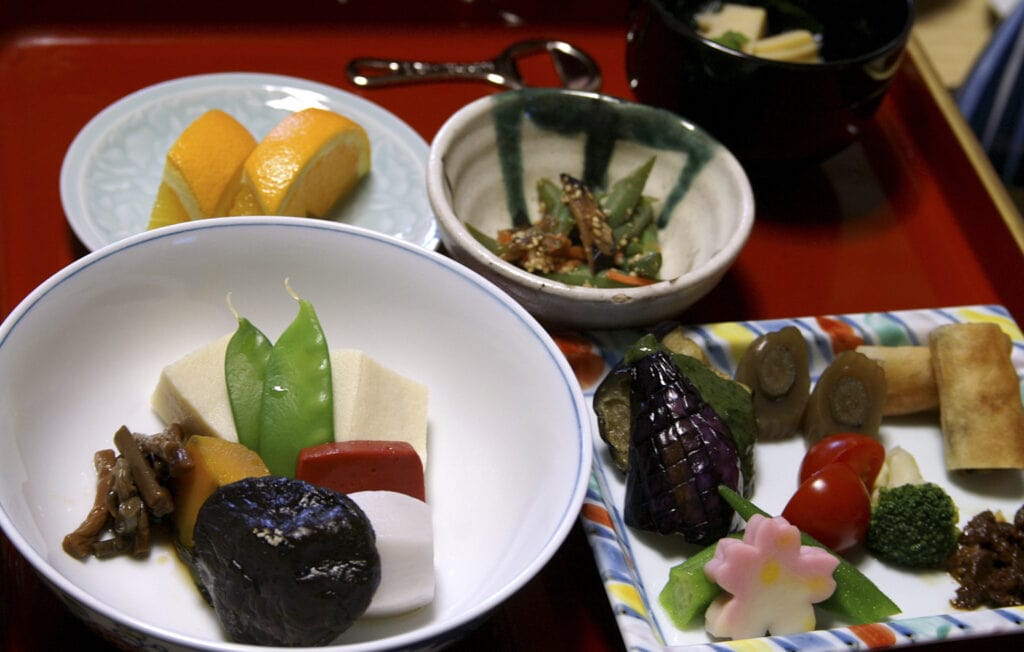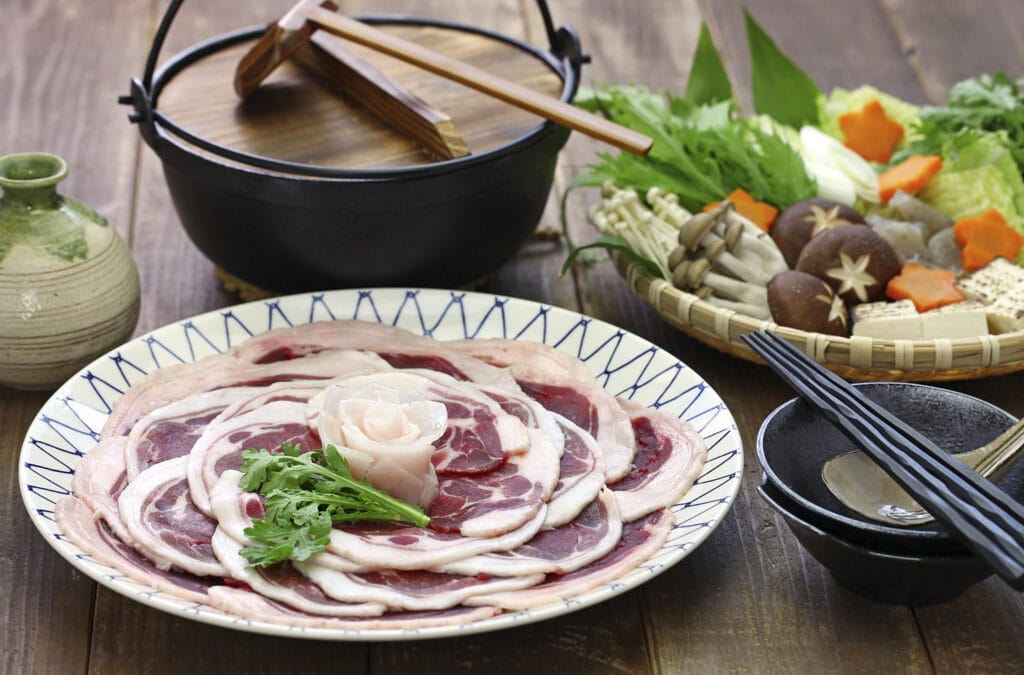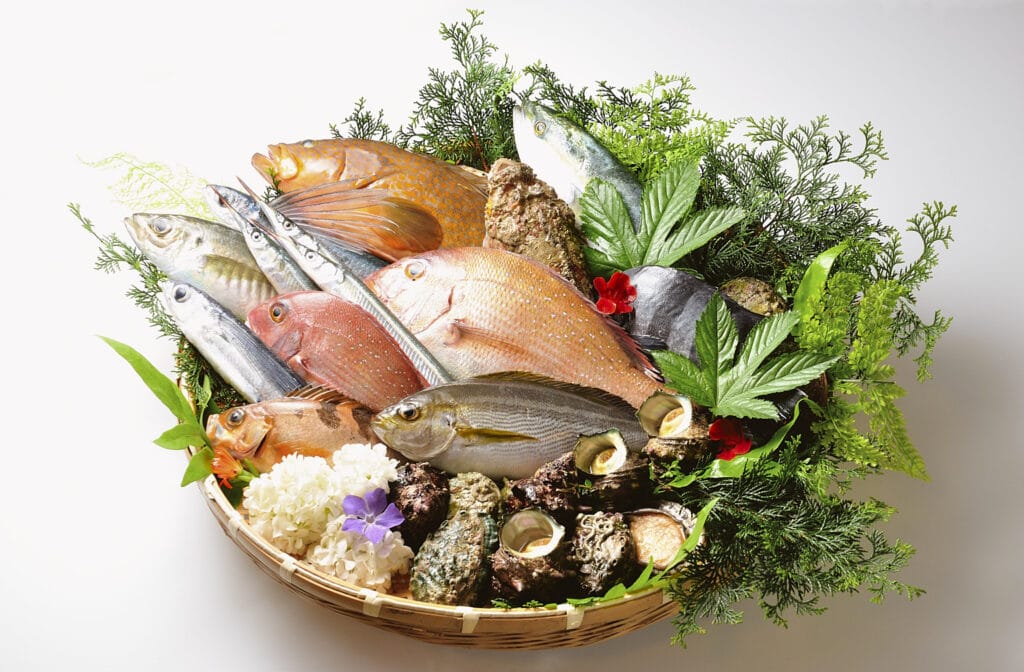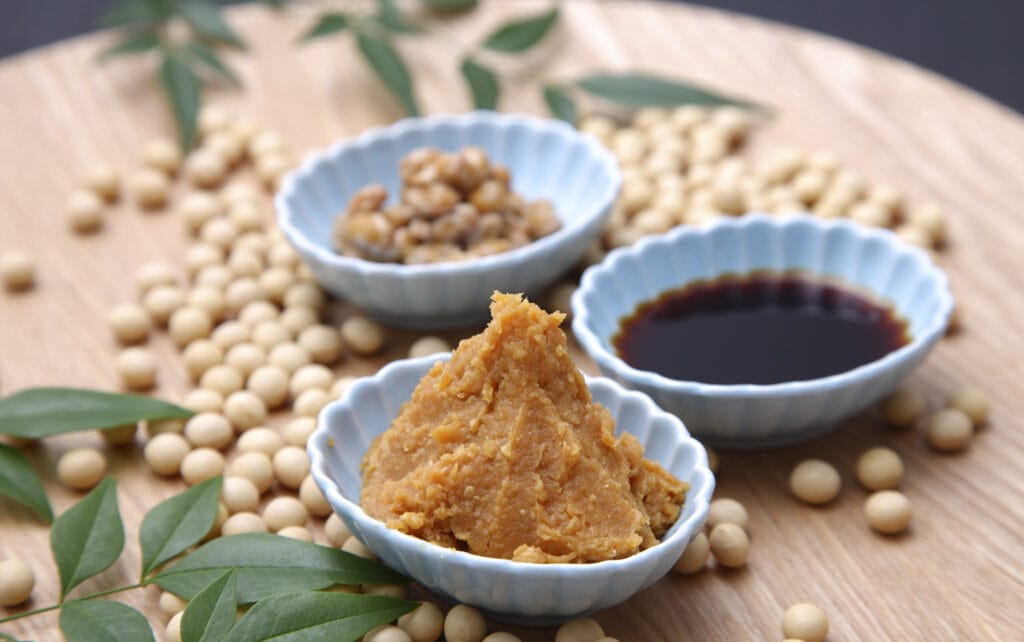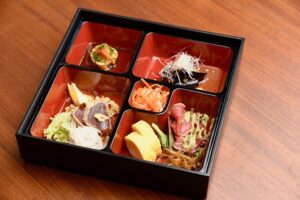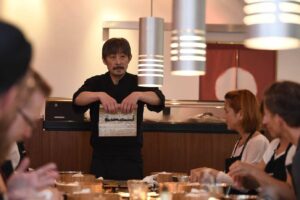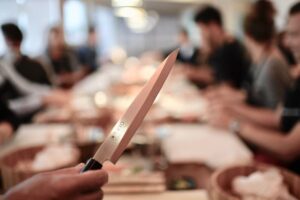Have you ever been to a Japanese restaurant and wondered what to eat if you are vegetarian or vegan?
Many menus in real Japanese restaurants don't seem to be vegetarian or vegan friendly...
Because alone Dashi, der allgegenwärtige Suppenfond der japanischen Küche, ist in der Regel eine Kombination aus Konbu (Seetang) und Katsuobushi (getrockneten Bonitoflocken). Also ist schon der typisch japanischen Miso-Suppe, die oft für vegetarisch gehalten wird, das Leben eines Fisches in die Wiege gelegt…
Vegetarianism rarer in Japan than in Germany
According to a survey from January 2023 the proportion of vegetarians and vegans in Japan is 5.9 % of the population.
Germany, on the other hand, already ranks second internationally after India (28 %) and Taiwan (14 %). in third place, with around 10 % of the population being vegetarian.
In India there are many followers of Hinduism, in Taiwan many followers of Taiwanese Buddhism and Taoism, and in these two countries religion and vegetarianism are considered to be closely linked. In Germany, on the other hand, health awareness, animal welfare and awareness of greenhouse gas emissions from animal husbandry are influential factors.
Meat used to be banned in Japan for a long time - officially...
What is less well known is that it was officially forbidden to eat meat in Japan for over 1,200 years.
Die alten Japaner kannten die Begriffe Kagere/穢れ (Verunreinigung), Kiyome /清め und Misogi (禊, beide Wörter bedeuten „Reinigung“). Es herrschte die Auffassung, dass der Verzehr von Tieren unrein war.
Sie aßen teilweise zwar Ente und anderes Geflügelfleisch sowie Wildschwein, verzichteten aber grundsätzlich auf den Verzehr von Tierfleisch und ernährten sich weiterhin vegetarisch auf der Grundlage von Gemüse und Getreide.
No livestock for consumption in ancient Japan
In a book from the 3rd century BC, the Japanese diet at that time was described as "warm weather, eating raw vegetables even in winter" and "diving into the water to catch clams and fish".
There are no descriptions of animals such as cows, horses or sheep from this period. In other words, the ancient Japanese ate a diet of cereals and rice as staple foods, plus plenty of fresh vegetables and fish and seafood, but no meat, i.e. pesco-vegetarian, which falls under the category of vegetarian.
At the same time, there were many Asian countries that raised livestock and ate meat. In China, for example, pigs and sheep were bred and eaten for meat.
Buddhist-influenced appreciation of life
When Buddhism was introduced in Japan during the Asuka period (710-794), the eingeführt wurde, verbreitete sich die Vorstellung, dass „Fleischessen böse ist“, aufgrund der buddhistischen Lehren, die das Töten von Tieren verbieten. Im Jahr 675 erließ Kaiser Temmu (天武天皇) ein Dekret, das Fleisch und Fleischessen verbot. Dieser Erlass verbot den Verzehr von Kühen, Pferden, Affen und Hühnern. Das Verbot wurde erst nach der Meiji-Restauration, etwa 1.200 Jahre später, aufgehoben.
Many nobles took refuge in Buddhism and therefore refrained from eating meat. When the meat ban später wieder aufgehoben wurde, wurde diese Veränderung kaum bekannt, denn die Mönche durften nicht in der Öffentlichkeit predigen. Die Ernährung des einfachen Volkes bestand weiter hauptsächlich aus Feldgemüse, Wildgemüse und braunem Reis.
Vegetarian cuisine under the influence of Zen Buddhism
In the Kamakura period (1185-1333), when the samurai came to power instead of the nobles, the ban on eating meat was temporarily lifted.
Andererseits beeinflusste der aus China stammende Zen-Buddhismus die Entwicklung der „vegetarischen Küche“, in der keine tierischen Produkte verwendet wurden. In der Edo-Periode (1603-1867) wurde „Shōjin-Ryōri“ (精進料理) zunächst in den Tempeln zubereitet und gegessen, aber während der Edo-Periode (1603-1867) wurde es oft in Restaurants im Auftrag der Tempel oder für besondere Gäste zubereitet- meist für Künstler oder Literaten, die nicht lived according to Buddhist teachings.
It was not until the middle of the Edo period that the ban on eating meat was strictly enforced again. His "Shōrui Awaremi no Rei" (生類憐みの令 Law for the Prevention of Cruelty to Animals) prohibited the slaughter and consumption of animals altogether.
Although this ban was lifted after Tsunayoshi's death, it had a major impact on the eating habits of the general public. Many Japanese were mainly vegetarian until the Meiji period (1868-1912), when the influence of Western civilization led to the emergence of a beef-eating culture.
"Hidden" meat consumption
However, this does not mean that people in the Edo period did not eat meat at all. In some restaurants, wild boar meat was called "Yama Kujira" (山鯨, mountain whale) or "Botan" (ぼたん, peony) and venison "Momiji" (もみじ, maple leaf) served in a "concealed language".
So although the consumption of meat was supposedly taboo in the Edo period, people simply used secret words to describe their favorite meat dishes.
Cattle and horses, which are an important source of meat today, were not consumed in Japan until the Meiji period, as they were essential for agriculture and warfare.
There is another interesting episode.
Omi beef - beef marinated in miso - from Shiga Prefecture is said to have the longest history in Japan.
Even during the Edo period (1603-1868), when meat was banned, Hikone clan sold beef called "Henpongan" (反本丸) as a medicine and donated it to the shogunate in Edo. It is also said to have been in constant demand by clans in various regions due to its delicious taste.
Another digression: pork in Japan
In Japan, wild boar have been bred since the Paleolithic hunted and eaten. The wild boar was bred and domesticated into a domestic animal, the pig. Pig bones have been found at sites dating back to the Yayoi period, and it is believed that the pigs imported from China were domesticated. In addition, there are descriptions of pigs bred in the homes of immigrants in old Japanese books.
However, due to the ban on eating meat, pig farming almost completely disappeared in Japan by the Heian period (794-).
After that, until the Meiji period (1868-), it seems that dishes containing pork were only eaten in what are now Okinawa and Kagoshima prefectures.
In 1872, after the end of the Edo Shogunate and the westernization of the country by the Meiji government, pig farming was fully introduced with the help of foreign experts.
Today, pork is an indispensable part of Japanese cuisine, including buta-jiru/豚汁 (miso soup with pork), buta-kakuni/豚角煮 and buta-shabu-shabu /豚しゃぶしゃぶ.
Fish has always been more important than meat
After the Meiji Restoration, the 1,200-year-old ban on meat consumption was lifted in Japan. However, the general public did not start eating meat in large quantities until much later. Most people, especially those who lived in coastal areas, did not eat meat because they had fish as a source of protein.
It was not until around 1960 that meat consumption in Japan began to spread to the general population. At that time, the annual per capita consumption of meat was around 3.5 kg. In 2013, it was 30 kg. Over the last 50 years, meat has become an integral part of the Japanese diet.
This has led to a high intake of fat and energy and the disadvantage that people eat far fewer vegetables. At the same time, diseases such as high blood pressure and diabetes have also increased in Japan and women are now concerned about the risk of breast cancer.
Gradually, we are hearing more and more advice that the Japanese should return to the grain-based vegetarian diet that has been practiced since ancient times for health reasons.
The sansaro restaurant also offers several vegetarian-friendly menus, e.g. dishes prepared exclusively with kombu dashi (seaweed broth) or without meat products.
Japanese cuisine and gluten
On the other hand, what about Japanese foods for those who need to avoid gluten, such as those with wheat allergies or coeliac disease? Studies have shown that the number of people with gluten problems in Europe is between 1.3 and 15% of the total population. In the United States, the figure is 3.7-8%. (Source)
In Japan, the percentage of people with food allergies is 1-2% of the total population, of which 8% have a wheat allergy, although the survey results do not specifically refer to gluten. (Source)
Gluten in der Sojasauce & Würzmitteln
Das erste große Problem ist die Sojasauce, ein wesentliches Würzmittel für japanische Speisen. Es gibt drei Hauptarten von Soy sauce: dunkle, helle und Tamari. Die meisten der beiden erstgenannten Sorten verwenden Gerste für den Fermentationsprozess. Gluten-empfindliche Menschen haben die Möglichkeit, Tamari-Sojasauce zu verwenden, während andere japanische Fischsauce verwenden (die drei wichtigsten japanischen Fischsaucen sind Shotsuru /しょっつる, Ishiru /いしる und Ikanago-Sojasauce /いかなご醤油).
Auch Miso, genannt Gerstenmiso (Mugi-miso, 麦味噌), und Getreideessig (Kokumotsu-su, 穀物酢) werden manchmal in der japanischen Küche verwendet, daher ist auch hier Vorsicht geboten. Kewpie-Mayonnaise, die in den letzten Jahren in Übersee populär geworden ist, ist ebenfalls nicht glutenfrei, weil sie Getreideessig auf Malzbasis als Zutat verwendet.
Tomato ketchup, which is rarely used in traditional Japanese cuisine but is used in Western Japanese cuisine, is also made with grain vinegar, so caution is advised here too.
Wer eine wirklich starke Unverträglichkeit von Gluten hat, der wird mit der japanischen Küche nicht glücklich, denn die „normale“ Sojasauce enthält Gluten und wird an allen Ecken und Enden in der japanischen Küche zum marinieren, vorbereiten und Kochen verwendet. Eine konsequent glutenfreie Ernährung ist daher schwierig. Bei Sushi und Sashimi kann man sich allerdings mit glutenfreier Tamari behelfen.
Hardly any gluten-free restaurants in Japan
In response to the increase in food allergies in Japan in recent years, various products have been developed in Japan to avoid gluten intolerance.
The number of products specializing in gluten-free cooking is gradually increasing and the range available for cooking at home is gradually expanding.
On the other hand, the number of allergy-friendly restaurants in Japan is still very small and an absolute exception.
So there are around 190,000 restaurants in Tōkyōbut only about 180 of them are gluten-free, making it difficult for allergy sufferers to eat out casually.
Also for our Restaurant sansaro it is not easy to always offer a special selection of gluten-free dishes in the usual authentic high quality, as there is simply a lack of Japanese spices and tasty recipes.
Gluten-free dishes in the restaurant sansaro
The gluten-free dishes at Sansaro include edamame, tofu salad (as long as it is not eaten with dressing sauce!), Sushi and Sashimi without mayonnaise (unless they are served with Soy sauce use tamari instead!).
Unlike grain vinegar, the rice vinegar used in sushi does not contain gluten.
Ice cream and matcha pudding are also gluten-free.
Tempura and Crispy Ebi Tempura are easy to recognize as they have a flour-based fried batter, but note that Goma Ae and Tonteki each contain soy sauce in their sauces.
Even with sushi, ikura gunkan and ikura maki are not gluten-free, as ikura is marinated in soy sauce.
Appendix: Further sources
Obayashi Quarterly,
History of Japanese people, food, and agriculture https://www.obayashi.co.jp/kikan_obayashi/detail/kikan_59_harada_4.html
Nutritional Knowledge of Meat: "The Buddhist Ban on Meat"
http://kumamoto.lin.gr.jp/shokuniku/eiyochisiki/bukkyo/index.html
Vegeness https://vegeness.com/blog/46283/
Edi guide https://edo-g.com/blog/2016/02/nikushoku.html
Association for Promoting the Production and Distribution of "Omi Beef"
https://oumiushi.com/about/history
Komorebi Blog of Flour allergyhttps://nhkomorebi.com/seasoning/#i-4
